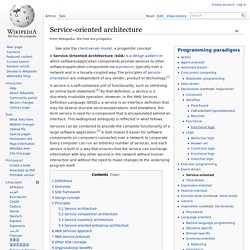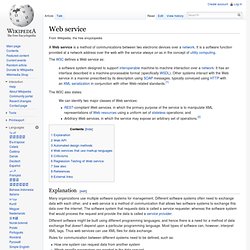

Ajax. Ajax is not a single technology, but a group of technologies.

HTML and CSS can be used in combination to mark up and style information. The DOM is accessed with JavaScript to dynamically display, and allow the user to interact with, the information presented. JavaScript and the XMLHttpRequest object provide a method for exchanging data asynchronously between browser and server to avoid full page reloads. In 1996, the iframe tag was introduced by Internet Explorer to load or to fetch content asynchronously. In 1998, Microsoft Outlook Web App team implemented the first component XMLHTTP by client script. Google made a wide deployment of standards-compliant, cross browser Ajax with Gmail (2004) and Google Maps (2005).[6] The term "Ajax" was publicly stated on 18 February 2005 by Jesse James Garrett in an article titled "Ajax: A New Approach to Web Applications", based on techniques used on Google pages.[1] get-ajax-data.js: send-ajax-data.php: jQuery example.
SOA. See also the client-server model, a progenitor concept A Service-Oriented Architecture (SOA) is a design pattern in which software/application components provide services to other software/application components via a protocol, typically over a network and in a loosely-coupled way.

The principles of service-orientation are independent of any vendor, product or technology.[1] A service is a self-contained unit of functionality, such as retrieving an online bank statement.[2] By that definition, a service is a discretely invokable operation. However, in the Web Services Definition Language (WSDL), a service is an interface definition that may list several discrete services/operations. And elsewhere, the term service is used for a component that is encapsulated behind an interface. Services can be combined to provide the complete functionality of a large software application.[3] A SOA makes it easier for software components on computers connected over a network to cooperate.
Overview[edit] Web service. A Web service is a method of communications between two electronic devices over a network.

It is a software function provided at a network address over the web with the service always on as in the concept of utility computing. The W3C defines a Web service as: a software system designed to support interoperable machine-to-machine interaction over a network. It has an interface described in a machine-processable format (specifically WSDL). Other systems interact with the Web service in a manner prescribed by its description using SOAP messages, typically conveyed using HTTP with an XML serialization in conjunction with other Web-related standards.[1] The W3C also states: We can identify two major classes of Web services:REST-compliant Web services, in which the primary purpose of the service is to manipulate XML representations of Web resources using a uniform set of stateless operations; andArbitrary Web services, in which the service may expose an arbitrary set of operations.[2]
RIA. Google trends shows (as of September 2012) that frameworks based on a plug-in are in the process of being replaced by HTML5/JavaScript-based alternatives.[3][4] RIAs dominate in browser based gaming as well as applications that require access to video capture (with the notable exception of Gmail, which uses its own task-specific browser plug-in).[7] Web standards such as HTML5 have developed and the compliance of Web browsers with those standards has improved somewhat.

However, the need for plug-in based RIAs for accessing video capture and distribution has not diminished,[8] even with the emergence of HTML5 and JavaScript-based desktop-like widget sets that provide alternative solutions for mobile Web browsing. Plug-ins[edit] Adobe Flash[edit] Main article: Adobe Flash Adobe Flash manipulates vector and raster graphics to provide animation of text, drawings, and still images. Java applet[edit] Main article: Java applet JavaFX[edit] Microsoft Silverlight[edit] HTML5/JavaScript[edit] ExtJS[edit]